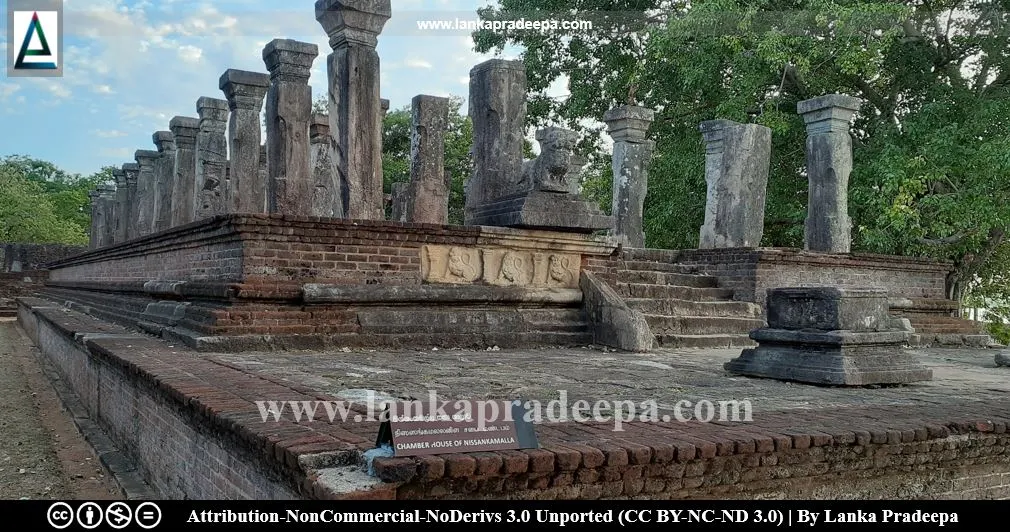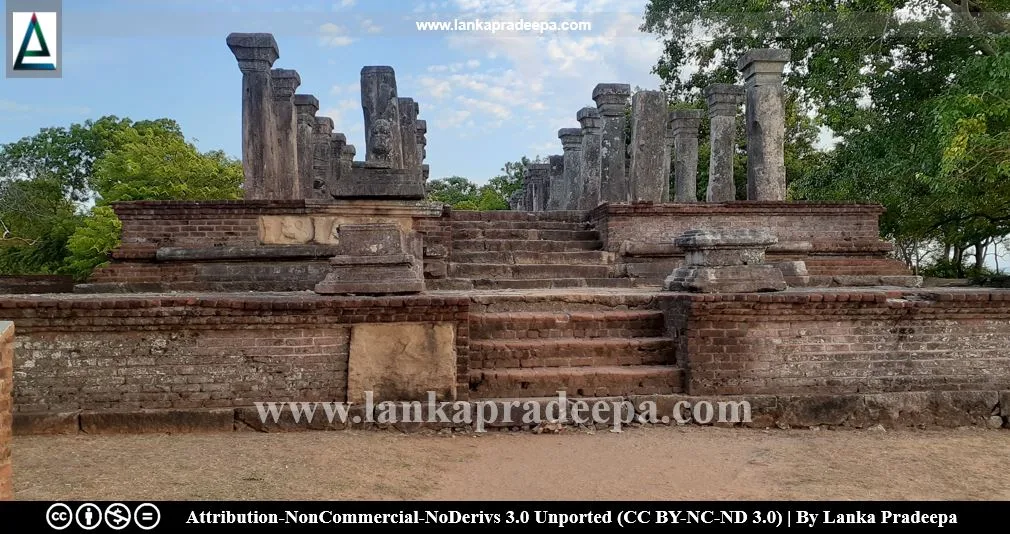
The Council Chamber/Royal Court of Nissankamalla (Sinhala: නිශ්ශංකමල්ල රාජ සභාව, පොළොන්නරුව) is located in the Ancient City of Polonnaruwa, Sri Lanka.
This monument is considered the best example found in Sri Lanka that
reveals the arrangement of an ancient royal council.
History
From the available epigraphical evidence, this building has been exactly identified as the Council Chamber of King Nissankamalla (1187-1196 A.D.). The stone lion figure placed at the southern end of the building is the throne of the king as indicated by the inscription inscribed under the belly of the lion (Jayasuriya, 2016). Also, the inscriptions found on the pillars of the chamber reveal the seating arrangement of the respective ministers and state officials in the royal council (Jayasuriya, 2016).
Inscriptions of the Royal Court of Nissankamalla
 Reign: Nissankamalla (1187–1196 A.D.)
Reign: Nissankamalla (1187–1196 A.D.)
Period: 12th century A.D.
Script: Medieval Sinhala
Language: Sanskrit mixed with Medieval Sinhala
Content: In the royal court complex, the stone lion throne is the seat of the king. The positions of the seats to be occupied by the other members including the viceroy, the heir apparent, the commander-in-chief, the chief scribe, the chief of staff, the commander, and the chairman of the chamber of commerce are denoted by the inscriptions inscribed on the pillars.
Reference: The information board at the site by the Department of Archaeology and the Ministry of National Heritage
 Reign: Nissankamalla (1187–1196 A.D.)
Reign: Nissankamalla (1187–1196 A.D.)Period: 12th century A.D.
Script: Medieval Sinhala
Language: Sanskrit mixed with Medieval Sinhala
Content: In the royal court complex, the stone lion throne is the seat of the king. The positions of the seats to be occupied by the other members including the viceroy, the heir apparent, the commander-in-chief, the chief scribe, the chief of staff, the commander, and the chairman of the chamber of commerce are denoted by the inscriptions inscribed on the pillars.
Reference: The information board at the site by the Department of Archaeology and the Ministry of National Heritage
Building

The building which is rectangular in shape has two consecutive levels. On the upper level are four rows of stone columns and each row contains twelve columns (Wikramagamage, 2004). The building can be entered through two entrances. Of them, the main entrance is facing the north and the other entrance faces the west (Wikramagamage, 2004). The remaining stone pillars indicate that they once had supported a roof covered with clay tiles (Wikramagamage, 2004).
A pillar containing an inscription of King Udaya II (887-898 A.D.) has been discovered in the vicinity of this building (Ranawella, 2001).


.


.
See also
References
1) Jayasuriya, E., 2016. A guide to the Cultural Triangle of Sri Lanka. Central Cultural Fund. ISBN: 978-955-613-312-7. p.72.
2) Ranawella, S., 2001. Inscription of Ceylon. Volume V, Part I. Department of Archaeology. ISBN: 955-9159-21-6. pp.133-137.
3) Wikramagamage, C., 2004. Heritage of Rajarata: Major natural, cultural and historic sites. Colombo. Central Bank of Sri Lanka. p.205.
2) Ranawella, S., 2001. Inscription of Ceylon. Volume V, Part I. Department of Archaeology. ISBN: 955-9159-21-6. pp.133-137.
3) Wikramagamage, C., 2004. Heritage of Rajarata: Major natural, cultural and historic sites. Colombo. Central Bank of Sri Lanka. p.205.
Location Map
This page was last updated on 14 November 2022

